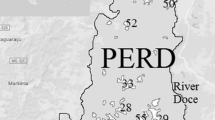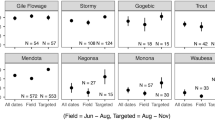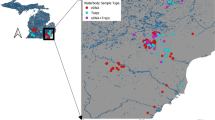Abstract
We tested the sampling methods of a volunteer-based monitoring program designed to detect the non-indigenous spiny water flea, Bythotrephes longimanus, and found that the program could detect themajority of Bythotrephes invasions. Volunteers take two vertical hauls with a 30 cm diameter net at each of three pelagic stations. To determine if the volunteers were using a large enough net at their three stations, we performed a 17-lake comparison of the volunteer's net with a 75 cm diameter, research-grade net. We found no difference in the number of stations at which Bythotrephes was detected (paired t-test, p = 0.155) with the two nets, because Bythotrephes densities were above the detection limits for both nets. To determine if three stations were sufficient to detect the invader with the volunteer's net, we deployed it at 30 stations in two lakes with average (Harp Lake, 4.17 Bythotrephes m-3) vs. low Bythotrephes densities (Sugar Lake, 0.92 m-3). In Harp Lake, repeated randomized sampling of the 30 sets of data indicated that only three stations were needed for 100% capture success. In Sugar Lake, seven stations were needed for 100% capture success, but three stations, the current program design, failed to detect the invasion only 14% of the time.
Similar content being viewed by others
References
Grigorovich, I. A., Pashkova, O. V., Gromoca, Y. F. and van Overdijk, C. D. A.: 1998, 'Bythotrephes longimanus in the commonwealth of independent states: variability, distribution and ecology', Hydrobiol. 379, 183–198.
Johannsson, O. E., Mills, E. L. and O'Gorman, R.: 1991, 'Changes in the nearshore and offshore zooplankton communities in Lake Ontario: 1981-88', Can. J. Fish. Aquat. Sci. 48, 1546–1557.
Mack, R. N., Simberloff, D., Lonsdale, W. M., Evans, H., Clout, M. and Bazzaz, F. A.: 2000, 'Biotic invasions: Causes epidemiology, global consequences, and control', Ecol. Applicat. 10, 689–710.
McNicol, D. K., Mallory, M. L. and Vogel, H. S.: 1995, 'Using volunteers to monitor the effects of acid precipitation on common loon Gavia immer) reproduction in Canada: the Canadian Lakes Loon Survey', Water, Air, Soil Pollut. 85, 463–468.
Ontario Federation of Anglers and Hunters: 1998, 'Volunteer zebra mussel monitoring program-an instruction manual for volunteers'.
Persaud, A. D. and Yan, N. D.: 2001, 'Accounting for spatial variability in the design of sampling programmes for Chaoborus Larvae', J. Plankton. Res. 23(3), 279–285.
Pimentel, D., Lach, L., Zuniga, R. and Morrison, D.: 2000, 'Environmental and economic costs of nonindigenous species in the United States', BioScience 50(1), 53–65.
Plissner, J. H. and Haig, S. M.: 2000, 'Status of a broadly distributed endangered species: results and implications of the second international piping plover census', Can. J. Zool. 78, 128–139.
Root, T.: 1988, 'Environmental factors associated with avian distributional boundaries', J. Biogeogr. 15, 489–505.
Sala, O. E., Chapin III, F. S., Arnesto, J. J., Berlow, E., Bloomfield, J., Dirzo, R., Huber-Sanwald, E., Huenneke, L. F., Jackson, R. B., Kinzig, A., Leemans, R., Lodge, D. M., Mooney, H. A., Oesterheld, M., Poff, N. L., Sykes, M. T., Walker, B. H., Walker, M. and Wall, D. H.: 2000, 'Biodiversity-Global biodiversity scenarios for the year 2100', Science 287, 1770–1774.
Schindler, D. W.: 2001, 'The cumulative effects of climate warming on other human stresses on Canadian frewshwaters in the new millenium', Can. J. Fish. Aquat. Sci. 58, 18–29.
Therriault, T. W., Grigorovich, I. A., Cristescu, M. E., Ketelaars, H. A. M., Vilganen, M., Heath, D. D. and MacIsaac, H. J.: 2002, 'Taxonomic resolution of the genus Bythotrephes Leydig using moecular markers and a re-eavluation of its global distribution, with notes on factors affecting despersal, establishment and abundance', Div. Distr. 8, 67–84.
Yan, N. D. and Pawson, T. W.: 1997, 'Changes in the crustacean zooplankton community of Harp Lake, Canada, following the invasion by Bythotrephes cederstroemi', Freshw. Biol. 37, 409–425.
Yan, N. D., Dunlop, W. I., Pawson, T. W. and Mackay, L. E.: 1992, 'Bythotrephes cederstroemi (Schoedler) in Muskoka lakes: first records of the European invader in inland lakes in Canada', Can. J. Fish. Aquat. Sci. 49, 422–426.
Yan, N. D., Blukacz, A., Sprules, W. G., Kindy, P. K., Hackett, D., Girard, R. E. and Clark, B. J.: 2001, 'Changes in zooplankton and the phenology of the spiny water flea, Bythotrephes, following its invasion of Harp Lake, Ontario, Canada', Can. J. Fish. Aquat. Sci. 58, 2341–2350.
Yan, N. D., Girard, R. and Boudreau, S.: 2002, 'An introduced invertebrate predator (Bythotrephes) reduces zooppankton species richness', Ecol. Letters 5, 481–485.
Rights and permissions
About this article
Cite this article
Boudreau, S.A., Yan, N.D. Auditing the Accuracy of a Volunteer-Based Surveillance Program for an Aquatic Invader Bythotrephes . Environ Monit Assess 91, 17–26 (2004). https://doi.org/10.1023/B:EMAS.0000009228.09204.b7
Issue Date:
DOI: https://doi.org/10.1023/B:EMAS.0000009228.09204.b7




